- Submissions

Full Text
COJ Technical & Scientific Research
Wide Aperture Non-Chain HF (DF) Lasers Initiated by Self-Sustained Volume Discharge Self-Organization Processes of Dissipative Structures
Apollonov VV* and Kazantsev S Yu
Prokhorov General Physics Institute, Russia
*Corresponding author:Apollonov VV , Prokhorov General Physics Institute, Russian Academy of Sciences, Moscow, Russia
Submission: June 11, 2019; Published: August 06, 2019

Volume2 Issue3August, 2019
Abstract
The properties of the self-sustained volume discharge development in gas mixtures of a non-chain electrochemical HF laser are shown to arise from the processes of self-organization of dissipative structures in the form of plasma diffuse channels. Consistent patterns of the formation of diffuse channels in a gas-discharge plasma of a self-sustained volume discharge are revealed.
Keywords: Self-sustained volume discharge; Self-organization; Dissipative structures; Non-chain HF(DF) chemical laser
Abbrevations: SSVD: Self-Sustained Volume Discharge; SIVD: Self-Initiated Volume Discharge
Introduction
A self-sustained volume discharge (SSVD) in the media of SF6 with H2(D2) and hydrocarbons has attracted the attention of researches due to the fact that these gases can be used as the working mixture of non-chain chemical HF(DF) lasers [1-5]. It was shown in [1-5] that in the case of electrochemical HF(DF) laser, if small-scale inhomogeneities are present on the cathode surface, an independent volume discharge develops in the form of a self-initiated volume discharge (SIVD), which does not require pre-ionization of a gas. The discovery of the SIVD made it possible to increase the output energy and power of nonchain electric-discharge HF (DF) lasers by more than an order of magnitude [3,4]. To date, almost all electric-discharge HF (DF) lasers, with an aperture of 10cm and larger, are built based on the approach developed in [1] and are intended to be used to initiate a non-chain chemical SIVD reaction. The simplicity of the implementation of a scalable SIVD in a number of highly electronegative gases makes the use of this type of volume discharge very promising not only for pumping active media of gas lasers [5,6], but also for designing various plasmachemical reactors. Therefore, the establishment of general properties inherent in this form of discharge is a very important task. Analysis of works [1,2] indicates that the SIVD, ignited in the working media of a non-chain HF(DF) laser, demonstrates the behavior typical of selforganizing systems that have recently been the subject of research on synergetics [7,8]. The purpose of this work was to study the possibility of applying the methods of synergetics and non-equilibrium thermodynamics to analyze the properties of the SIVD formation in working media of a non-chain HF(DF) laser. To this end, we critically revised the results of experimental studies of our earlier work [1-4] and performed a number of additional experiments without the use of UV of the cathode in order to eliminate external influence on the SIVD structure.
Experimental setup and research methods
The following notations are adopted: Rs is the current shunt; SG is the spark gap under pressure; C is the pump capacity, L is the inductance of the pump circuit; and R1 and R2 are the high voltage dividers. The experiments were performed in a cylindrical dielectric discharge chamber filled with gas mixtures at a total pressure p=1÷250Torr. The SIVD was ignited in the discharge gap (DG) with different configuration of electrodes (Figure 1) at pd=0.02÷0.9cmatm (p is the mixture pressure, and d is the interelectrode distance). The mixture of technically pure SF6 with hydrogen or hydrocarbons (C2H6, C3H8, C-C6H12) was supplied into the discharge chamber. To identify some features of the SIVD development in working mixtures of a non-chain HF laser, other gases (C3F8, C-C3F8, C2HCl3, CO2, Ar, He, Ne, and N2) were also injected into the discharge chamber. The SIVD dynamics was examined under the same experimental conditions as in [1]; however, instead of an artificial line forming a constant amplitude current pulse at the DG, a capacitor discharged at the DG (Figure 1a). The capacitance and inductance of the circuit varied during the experiments.
Figure 1:Scheme of the experimental setup: (a) DG is formed by two disk electrodes, rounded along the edge (b) DG is formed by a wire in polyethylene insulation (cathode) and a semicylinder (anode) [14].
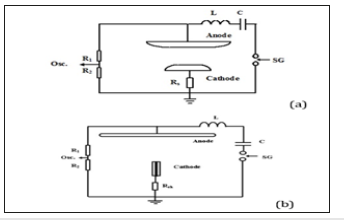
To study the effect of temperature on the SIVD characteristics, the gas in the DG was heated using a pulsed CO2 laser before applying a high-voltage pulse [9,10]. The scheme of the experimental setup is shown in Figure 2; the experimental technique was the same as that described in [11]. The gas was preheated only in a narrow DG zone. This was achieved by irradiating the DG with a pulsed CO2 laser through a slit diaphragm D of width H=12mm, oriented perpendicular to the direction of the applied electric field. This irradiation scheme makes it possible to observe the SIVD contraction directly in the volume of the heated gas (similar to glow discharge contraction [12]), rather than in the form of a channel sprouting out of the cathode spots and overlapping the gap during its development [13]. The gas temperature Tg, which is set in the SIVD combustion zone, was determined by the laser energy absorbed by SF6 molecules [14], and also by the velocity of propagation of the shock wave formed at the boundaries of the cold and heated gas [15]. The temperature Tg was varied in the range from 800 to 2400K (the specific energy of the laser radiation absorbed by SF6 in the SIVD combustion region, 0.05 0.25 . 3 a W = − J cm− . The voltage pulse was applied to the discharge gap with a delay τ = 4μ s with respect to the laser pulse, which ensured the establishment of thermal equilibrium between the translational and internal degrees of freedom in the irradiated gas by the beginning of the discharge in the pressure range in question [14]. In the course of the experiments, we controlled the DG voltage and the SIVD current and took photos of the SIVD with a digital camera synchronized with a laser pulse.
Figure 2:Schematic of the experimental setup: (A) attenuating films; (NaCl) NaCl wedges branching off part of the radiation to the energy meter (EM) and photodetector (PD); (D, S) diaphragm or screen setting the irradiation profile of the discharge gap; (W) BaF2 windows; (DC) digital camera; (F) controlled spark gap; (C) capacity; (L) inductiveness; (R1, R2) resistance divider; (Rsh) current shunt; (Osc) digital oscilloscope.
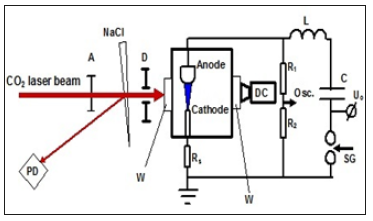
Experimental results and discussion
Figure 3:SIVD photograph in mixture SF6: H2=10: 1 at a total pressure 33 Torr.
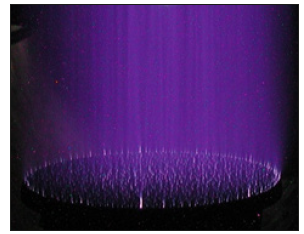
Figure 4:Cathode photographs taken for different values of the specific energy input to the SIVD plasma: the discharge duration, τdis=260ns; the mixture, SF6: C2H6 = 30: 3Torr; and the interelectrode distance, d = 4cm.

Experimental studies revealed the following properties of the SIVD formation. The SIVD has a fundamentally jet structure and consists of a multitude of diffuse channels originated from cathode spots. Figure 3 shows a typical SIVD photograph in an SF6: H2 =30: 3Torr gas mixture. The photograph was taken through the discharge chamber window when a discharge with a duration of 240ns was ignited in the DG with an interelectrode distance d=6cm (win~80J/l.). The process of filling the discharge gap with plasma is as follows: first, several diffuse channels appear along the perimeter of the cathode in the zone of the maximum electric field amplification, and then, as the electrical energy is introduced into the discharge plasma, new diffuse channels appear. It is noteworthy that the discharge glow in the rest of the DG, where there are no cathode spots, is not registered at this time, which is confirmed by SIVD studies performed using a high-speed camera with a 20ns frame exposure [4]. Figure 4 shows integral photographs of the cathode in the SF6/ethane mixture, taken when a capacitor was discharged at the DG. The energy introduced into the SIVD plasma is indicated under the photo (Figure 4). In these experiments, the charging voltage was varied at a fixed discharge duration, and the UV illumination of the DG to stabilize the breakdown time was not used.
The magnitude of the specific energy input, in contrast to the conditions shown in Figure 3, was specially chosen to be low in order to monitor the process of filling the DG with a gas-discharge plasma. One can see from Figure 4 that the formation of new cathode spots and their filling of the cathode from the perimeter to the center occurs with an increase in the electrical energy introduced into the discharge. A diffuse channel that grows from a cathode spot is a typical example of a dissipative structure, which exists due to supply of energy from an external source. The results of experiments [5,12] indicate that the cathode spots and the resulting channels appear on nanosecond time scales (<20ns); the volume occupied by the discharge plasma increases discretely through the formation of new dissipative structures. With an increase in the specific energy input, the cathode spots are uniformly distributed over the cathode surface, and diffuse channels fill the entire discharge volume. The general theory of self-organizing systems states that the number of the formed structures will be such that given the conditions imposed on the system by the amount of energy (electric charge) applied to it, the entropy-production rate be minimal [7]. Thus, due to the formation of new structures, a non-equilibrium system in our case, SIVD plasma will tend to minimize the production of entropy, which is determined by the dissipation function. The dissipation function during the discharge current flow is determined in accordance with [8] by the expression (the integral is taken over the entire volume occupied by the SIVD plasma):

Here j is the current density, E is the electric field strength in the discharge gap, Tg is the gas temperature, t is the time, and T is the duration of the discharge current pulse. Note that

is the energy input into the plasma of a single element of the dissipative SSVD structure. Taking into account its discrete structure, the amount of energy supplied into the total volume of the discharge plasma can be written through the sum of the energies dissipated in each dissipative structure:

It follows from the experiment that with other parameters being constant, the number of dissipative structures formed linearly increases with the energy supplied into the SSVD plasma [2]. The behavior of the SIVD is similar to that of a living organism, the cell of which initially grows as it is supplied with energy and building blocks from outside a living cell. When the cell attains a certain critical size, cell division is initiated, with the result that the total number of cells increases in proportion to the resources available for cell nutrition. From the point of view of non-equilibrium thermodynamics, the need for cell division is determined by the condition of minimizing the rate of entropy production inside a dissipative structure (cell) [8,10]. With an increase in cell size, entropy production increases in proportion to its volume, dSc / dt = kcV , and the dissipation rate of excess entropy produced during the life of a cell is proportional to its surface, / i i dS dt = kψ Here, V is the volume of the structure, kc is the entropy-production rate per unit of volume, ki is the rate of excess entropy dissipation to the external environment through a unit area of the structure, and Ψ is the cell surface area. Thus, with an increase in the characteristic cell size r, the cell volume grows in proportion to V ~ r3 , and the surface increases asψ = r2 . It means that there is a certain critical size of the structure, rc, at which the total entropy production, equal to the difference between the entropy-production rate of a cell and the entropy dissipation rate to the external environment, will be minimal. We observe something similar in dissipative structures in the discharge, which after their formation increase in transverse size, but then, as energy is supplied into the system, new plasma structures appear, and the current flowing through the initially formed structures decreases. The phenomenon of a decrease in the current flowing through the structure with an increase in the total current is indeed observed in experiments [1,9]. There is the same tendency in the calculations of the characteristics of a gas-discharge plasma, if we take into account such nonlinear processes as SF6 dissociation by electron impact, electron-ion recombination, and the separation of electrons from negative ions [3]. Since from the most general considerations it follows that the critical size of a structure is proportional to the ratio of the entropy-dissipation to rate the external environment to the entropy-production rate, it becomes obvious that with increasing gas pressure the size of the structure will decrease and the number of structures will increase. This, in fact, is confirmed by studies [2], in which it has been experimentally established that the number of structures is determined by the relationship:

Here, a and b are the constants depending on the composition of the gas mixture and the electrode system. Note that the physical mechanism preventing the output of all the energy through a single channel is governed by the effect of limiting current density, which was studied in detail in [3]. However, the appearance of new structures in the discharge with variations in parameters such as gas temperature, pressure and energy input into the plasma is uniquely determined by expression (1), regardless of the mechanism which is responsible for the effect of limiting current density. The triggering mechanism that initiates the processes of self-organization is the development of plasma instability and the presence of negative feedback, which prevents the development of instability in the spark channel, in the self-organizing system [11]. The type of discharge instability is also not critical, since, apparently, many of the instabilities described in [12,13] can lead to the formation of plasma structures; however, in working mixtures of a non-chain HF laser in the volume of the discharge gap, the detachable instability is most likely to occur, which was first described in [14,15], and the negative feedback is caused by the effect of limiting current density [2]. To make sure that expression (1), in fact, allows us to describe the behavior of the discharge upon varying the experimental conditions, we will consider the effect resulting from an increase in the gas temperature, with other conditions being the same. It follows from the analysis of the dissipation function (1) that with an increase in the denominator, processes should arise that lead to an increase in the numerator, since from (1) the functional has an extreme value [8]. Indeed, the experiments prove that an increase in the gas temperature Tg results in additional filamentation of the discharge and in the formation of new dissipative structures in the heating region [4]. Figure 5 shows photographs of a discharge with the duration of 150ns obtained in an SF6: Ne: C2H6 gas mixture at a total pressure of 18Torr; the conditions of the experiment are described in [14].
The photographs in Figure 5a & 5b were obtained under conditions when the central part of the 12mm wide discharge gap was pre-heated by the radiation of a pulsed CO2 laser to a temperature Tg, and in Figure 5c the gas in the central region of the discharge was not heated up before applying a high-voltage pulse and the temperature was equal to room temperature. One can see from Figure 5 that plasma structures are formed in the regions of the discharge gap having a higher temperature. Figure 6 shows the dependence of the characteristic SSVD-photograph-averaged transverse size of the plasma structure on the temperature of the gas Tg in the laser-heated region of the discharge gap; the dependence was obtained on the basis of the experimental data [14,15]. One can see from Figure 6 that the characteristic transverse size of the structure (channel diameter) is inversely dependent on temperature, which agrees with expression (1). Taking into account the fact that the structures formed in the discharge have axial symmetry, i.e. represent filaments or channels of radius rc=dc/2=ki/ kc, and also based on the condition that the entropy produced in the structure does not exceed the entropy that dissipates through the outer edges of the structure, it follows that the transverse size of the channel rc decreases with increasing concentration of polyatomic molecules in the discharge gap. This conclusion is also confirmed by experimental studies [3,9]. Thus, the features of the dynamics of the self-sustained volume discharge formation in working mixtures of a non-chain HF(DF) laser are due to the process of self-organization of dissipative plasma structures produced in the process of the discharge gap breakdown. To analyze the patterns of generation and functioning of these structures, one can successfully use the methods of synergetics and non-equilibrium thermodynamics.
Figure 5:Photographs of the SIVD in the SF6: Ne: C2H6 = 5: 5: 1 gas mixture: Tg= (a) 1550, (b) 850 and (c) 298K.
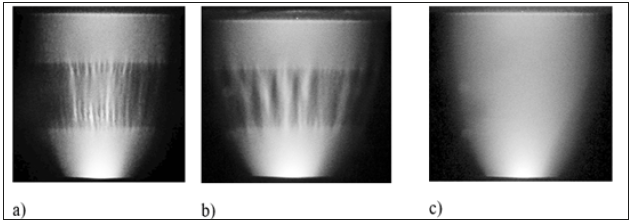
Figure 6:Dependence of the average transverse diameter of the plasma structure,
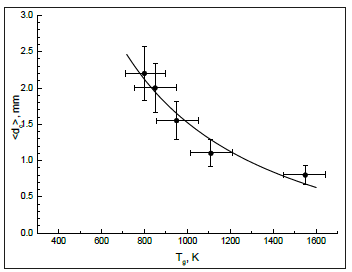
Conclusion
Thus, the features of the dynamics of the self-sustained volume discharge formation in working mixtures of a non-chain HF(DF) laser are due to the process of self-organization of dissipative plasma structures produced in the process of the discharge gap breakdown. To analyze the patterns of generation and functioning of these structures, one can successfully use the methods of synergetic and non-equilibrium thermodynamics. High energy/ power non-chain HF(DF) laser has a very bright future and a very wide spectrum of applications. To solve the problem of scalability up to the multi-kJ level necessary features of the discharge gap breakdown should be carefully investigated.
References
- Apollonov VV, Firsov KN, Kazantsev SY, Oreshkin VF (1998) High-power nonchain HF (DF) lasers initiated by self-sustained volume discharge. Proceedings SPIE 3574: 374.
- Apollonov VV, Belevtsev AA, Kazantsev SY, Saifulin AV, Firsov KN (2000) Self-initiated volume discharge in nonchain HF lasers based on SF6-hydrocarbon mixtures. Quantum Electron 30(3): 207.
- Apollonov VV (2016) Self-controlled volume-discharge lasers and applications. High-Energy Molecular Lasers.
- Belevtsev AA, Firsov KN, Kazantsev SY, Kononov IG, Podlesnykh SV (2018) Self-sustained volume discharge in mixtures of SF6 with hydrocarbons, hydrogen and deuterium for non-chain HF(DF) lasers. Journal of Physics D: Applied Physics 51(38): 384003.
- Vagin NP, Yuryshev NN (2001) Pulsed chemical oxygen-iodine laser initiated by a transverse electric discharge. Quantum Electron 31(2): 127.
- Belevtsev AA, Kazantsev S Yu, Saifulin AV, Firsov KN (2003) Self-initiating volume discharge in iodides used for producing atomic iodine in pulsed chemical oxygen-iodine lasers. Quantum Electron 33(6): 489.
- Nicolis G, Prigogine I (1977) Self‐organization in nonequilibrium systems. From dissipative structures to order through fluctuations. The Quarterly Review of Biology.
- Trubetskov DI, Mchedlova ES, Krasichkov LV (2005) Introduction to the theory of self-organization of open systems Moscow: Fizmatlit, Russia.
- Apollonov VV, Belevtsev AA, Kazantsev S Yu, Saifulin AV, Firsov KN (2002) Development of a self-initiated volume discharge in nonchain HF lasers. Quantum Electron 32(2): 95.
- Ebeling W (1976) Structure formation in irreversible processes. Teubner, Leipzig, Germany.
- Kerner BS, Osipov VV (1990) Self-organization in active distributed media: scenarios for the spontaneous formation and evolution of dissipative structures. Sov Phys Usp 33(9): 679.
- Napartovich AP, Starostin AN (1979) In Plasma Chemistry. In: Smirnov BM (Ed.), Moscow Atomizdat, Russia, 6: 153.
- Mesyats GA (1995) Ecton or electron avalanche from metal. Phys Usp 38(6): 567.
- Belevtsev AA, Firsov KN, Kazantsev S Yu, Kononov IG (2009) Electron detachment instability and self-organization in strongly electronegative polyatomic gases. J Phys D: Appl Phys 42(21): 215205.
- Belevtsev AA, Kazantsev S Yu, Kononov IG, Firsov KN (2010) Detachment instability of self-sustained volume discharge in active media of non-chain HF(DF) lasers. Quantum Electron 40(6): 484.
© 2019 Apollonov VV. This is an open access article distributed under the terms of the Creative Commons Attribution License , which permits unrestricted use, distribution, and build upon your work non-commercially.
 a Creative Commons Attribution 4.0 International License. Based on a work at www.crimsonpublishers.com.
Best viewed in
a Creative Commons Attribution 4.0 International License. Based on a work at www.crimsonpublishers.com.
Best viewed in 







.jpg)






























 Editorial Board Registrations
Editorial Board Registrations Submit your Article
Submit your Article Refer a Friend
Refer a Friend Advertise With Us
Advertise With Us
.jpg)






.jpg)














.bmp)
.jpg)
.png)
.jpg)










.jpg)






.png)

.png)



.png)






